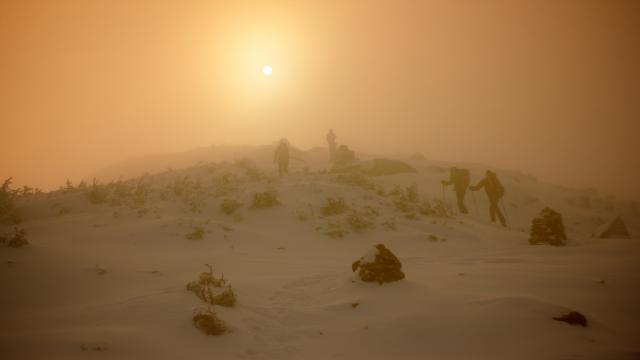The windiest mountain in the world isn’t in some far flung place, it’s in New Hampshire. Mt Washington’s winds can top 320km/h and its temperatures fall as low as -44C. During one of the coldest Februarys on record, we decided to climb it, along with the six other peaks that make up the Presidentials.
Mt Washington sits at the heart of the White Mountains, in the middle of a high ridge: the Presidentials. Named, funnily enough, after the White House’s oldest and boldest, the range includes the highest seven peaks in the Northeast. Completing a traverse of the seven peaks, a 37km trek with 2700m of elevation, is a famous challenge — in summer.
Why is Washington so windy? According to Wikipedia:
The weather of Mount Washington is notoriously erratic. This is partly due to the convergence of several storm tracks, mainly from the Atlantic to the south, the Gulf region and Pacific Northwest. The vertical rise of the Presidential Range, combined with its north-south orientation, makes it a significant barrier to westerly winds. Low-pressure systems are more favourable to develop along the coastline in the winter months due to the relative temperature differences between the Northeast and the Atlantic Ocean. With these factors combined, hurricane force wind gusts are observed from the summit of the mountain on average of 110 days per year.
In winter, the weather on the high peaks takes a turn for the worse. The wind breaks 320km/h, temps drop below -40C with windchill, visibility becomes nonexistent, and generally it’s just a terrible place to try and survive. In fact, a well-prepared hiker with mostly appropriate gear and a sensible plan died on the first 2km of the ridge last weekend.
Our plan, on the other hand, started as all good plans should: over a pitcher of beer somewhere after midnight. My friend Nils and I convinced ourselves that doing a one-day attempt in February would be a good idea and in some way not insane. The logic (as far as there was logic) went like this: we’d keep an eye on the weather, pick a weekend with low winds and bearable temps, drive down, start hiking early, and do the thing in a (long) day, rather than the usual two or three.
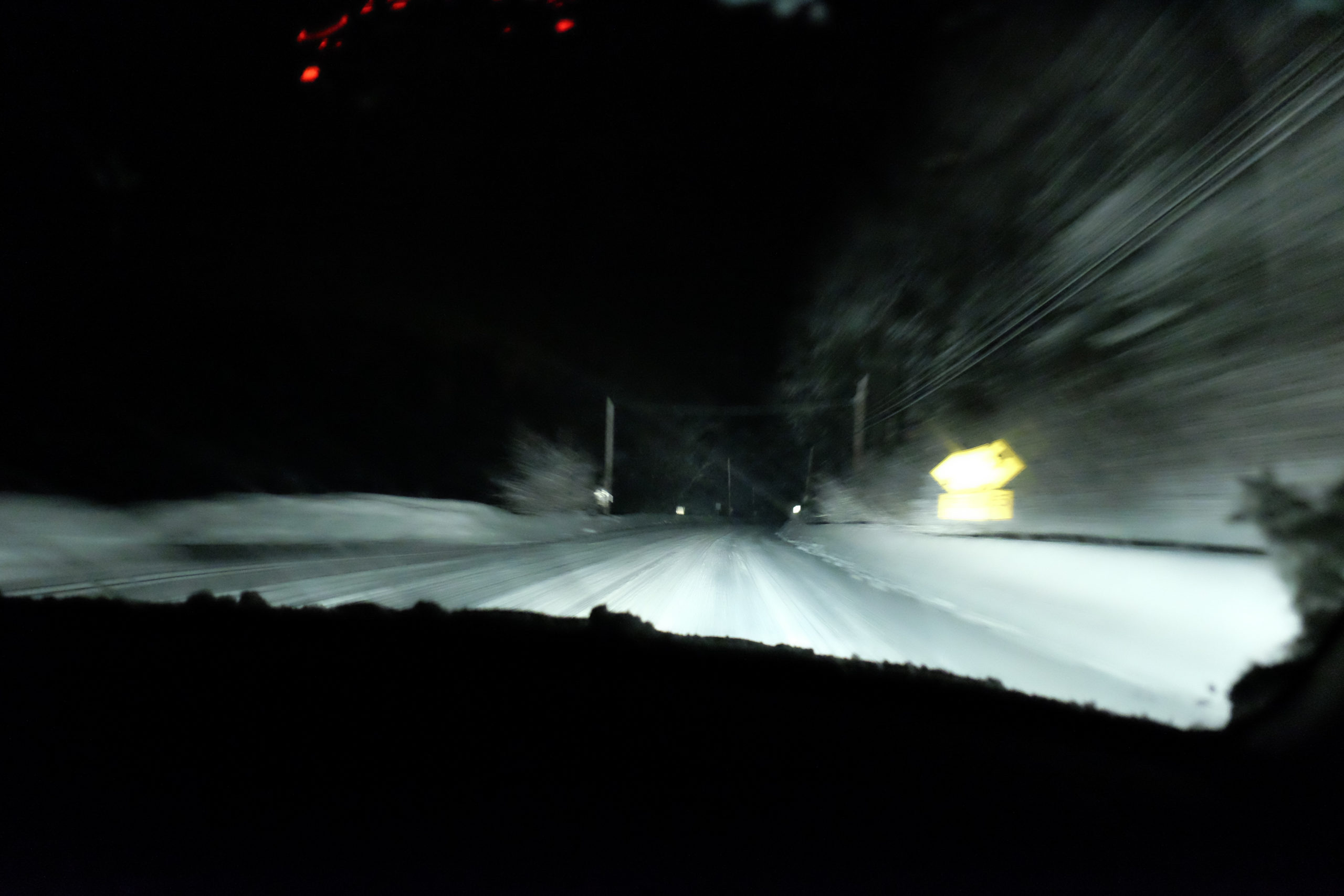
So, around 5 last Saturday afternoon: the five of us (oh yeah: we roped three other dumb idiots into this) piled into Nate’s Subaru and powered straight into a snowstorm on the highway. You’ve probably stereotyped the Canadians as polite drivers who know what to do when it starts snowing, but given the number of cars facing upstream, I can promise you otherwise. I’ve felt safer biking down a Russian highway.
The snow turned a three-hour drive into a five-hour epic, albeit with a pause at a truck stop for a calorie binge in best American style: grilled cheese, piles thereof. At 11, we arrived at Nate’s place close to the mountains, napped for two hours, skimmed the maps, and hit the road.
Another snowy drive (spoiler: plowing in New Hampshire isn’t the greatest after midnight) got us to the Appalachia trailhead around 3.30am. There’s not much to see at the start: a winter parking lot is more of a widening of the road. In the snowbanks was a lean-to with maps and the first (of many) dire warnings of crummy alpine weather conditions.
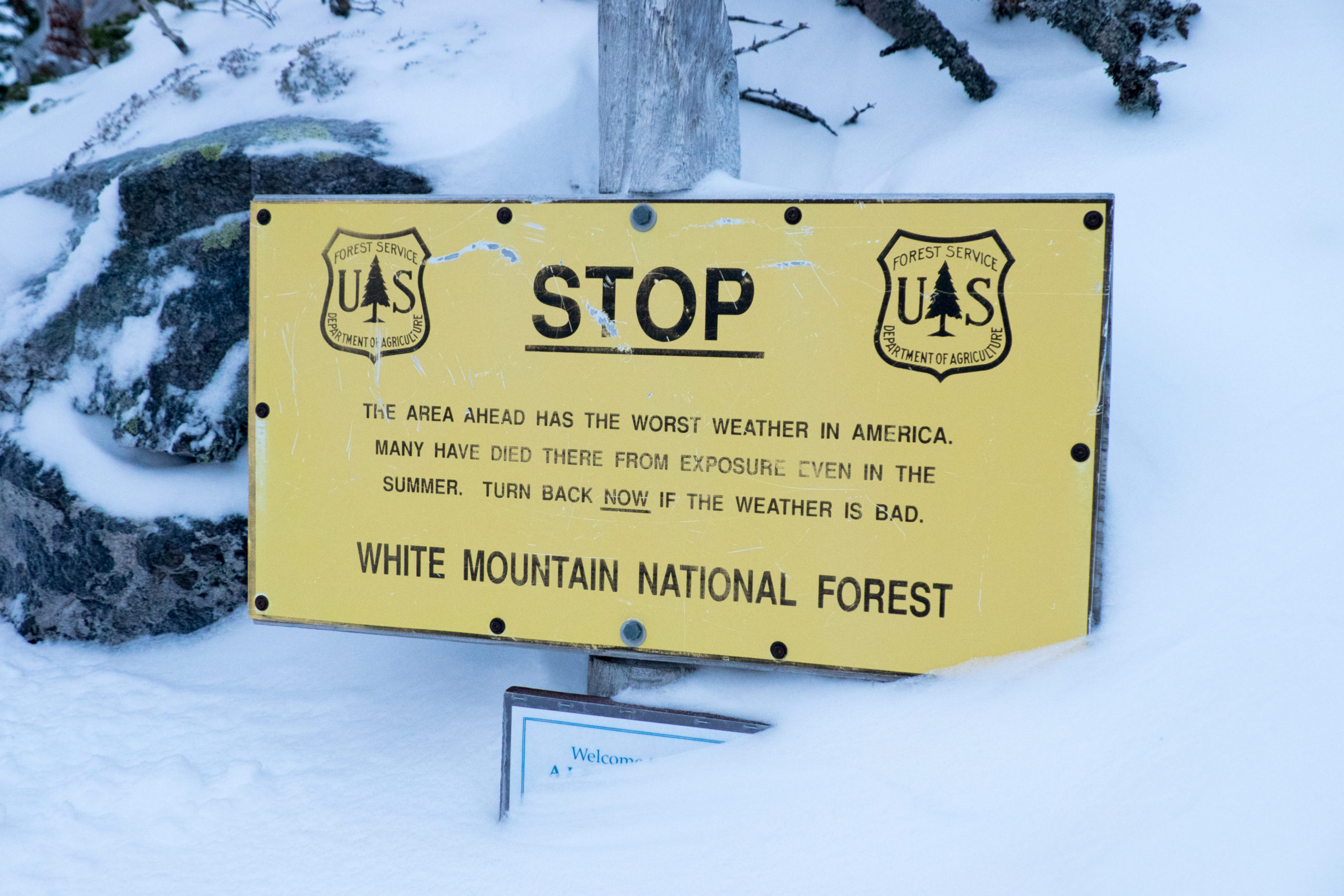
Between the five of us, we didn’t take much emergency gear: Julien and Nate split a shovel, so we could dig a snow shelter in case shit hit the fan, Charlie had a single three-season sleeping bag; I had a first aid kit, a bivy bag, and split a stove and gas bottle with Nils. That’s enough gear for a casualty to survive, but only for a night out if you’re Bear Grylls running on antifreeze. We’re not Bear Grylls. We were relying on finishing before dark, and sub-7kg packs were the only hope of that.
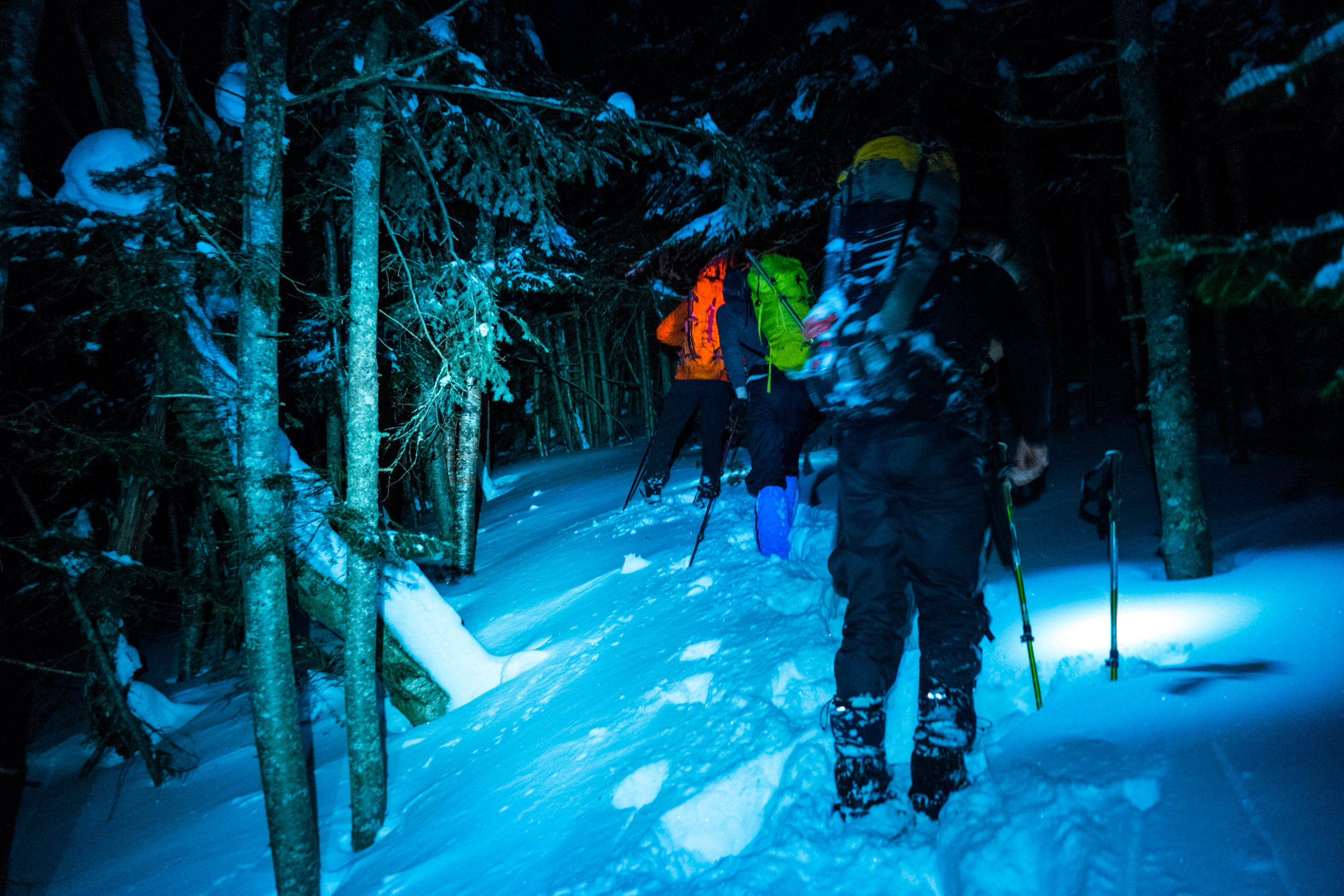
We strapped snowshoes on, and hit the Valley Way trail by headlight around 4am. The first 6km wind their way up through the trees to Madison Hut. It’s a pretty sucky climb from 300m to 1400m, and in the dark there’s no view to speak of, so we slogged up for an hour and a half until we hit treeline.
Just as the sun rose, dense pines gave way to small bushes, and the packed trail to deep snow. There’d been 30cm of fresh powder in the previous 12 hours, and all of it had settled on the trail. Snowshoes were ineffective (read: a goddamn liability) on this steep slope, so our pace slowed dramatically as Charlie and Nils (who was hands-down the strongest guy on the trip, although I still think his pack was too light) broke trail up a 800m of thigh-deep powder.

Picture: Charlie Beard
We reached the Madison hut just as the sun peeked over the horizon. I’ve visited the hut in summer: it’s a big, friendly place with staff, and bowls of hot soup for a dollar. In winter, it’s boarded up and snowed in, with just enough space round the back to hide from the wind.
We dropped packs at the hut and raced up Mt Madison, tagging the 1636m summit, and grabbing a photo across the White Mountains. The cloud base sat a 300m below the peaks, and without other hikers stupid enough to be up on the ridge at 8am, it had an impressively desolate feel — we were in the alpine, and without having to go out west!
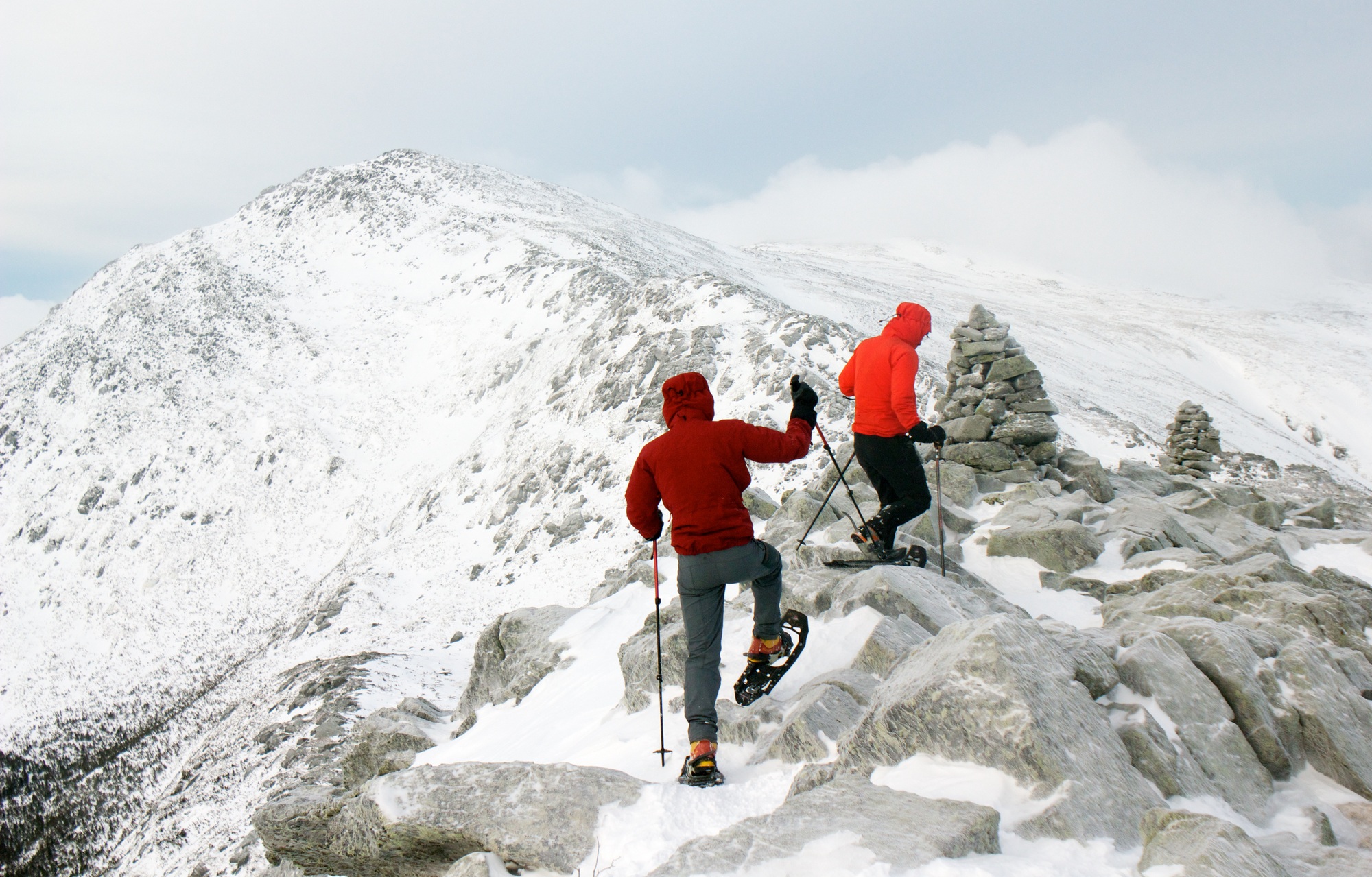
Picture: Charlie Beard
From Madison, there are six more summits in the Presidential traverse: Adams and Jefferson, both big hikes over 1676m, with some soul-crushing up-and-down between; then Washington, at 1917m the big boy of the range. From there, the game gets easier with Monroe, Eisenhower, Pierce, and a long walk out. We’d bail off the route if we weren’t climbing Washington by noon — a turn-back time helps with summit fever, and also gave us a midway goal to aim for. We left Madison hut aiming for Adams at 8.30, feeling like we’d be drinking beer by early afternoon.
Just after hitting the trail, though, we (and by we, I mean me) made our one and only big mistake of the day. Navigation on the ridge is normally dead simple: there are signposts everywhere, and cairns (big ‘ole piles of rocks) litter the paths just in case. But with feet of snow on the ground, route-finding was tricker than we realised, and we ended up on the smaller of two trails up Mt Adams.

Picture: Charlie Beard
In the summer, that isn’t a problem: the Star Lake trail involves a tiny bit of scrambling, but by all accounts it’s just another fun way up to the summit. In winter, it turned into a slogfest. Swimming up powdery gullies, the snowshoes were worse than useless, and it took us an hour to cover ground that should have taken 10 minutes. (Although, silver lining: I found that class 4 scrambling in snowshoes is easier and more fun than you’d imagine.)
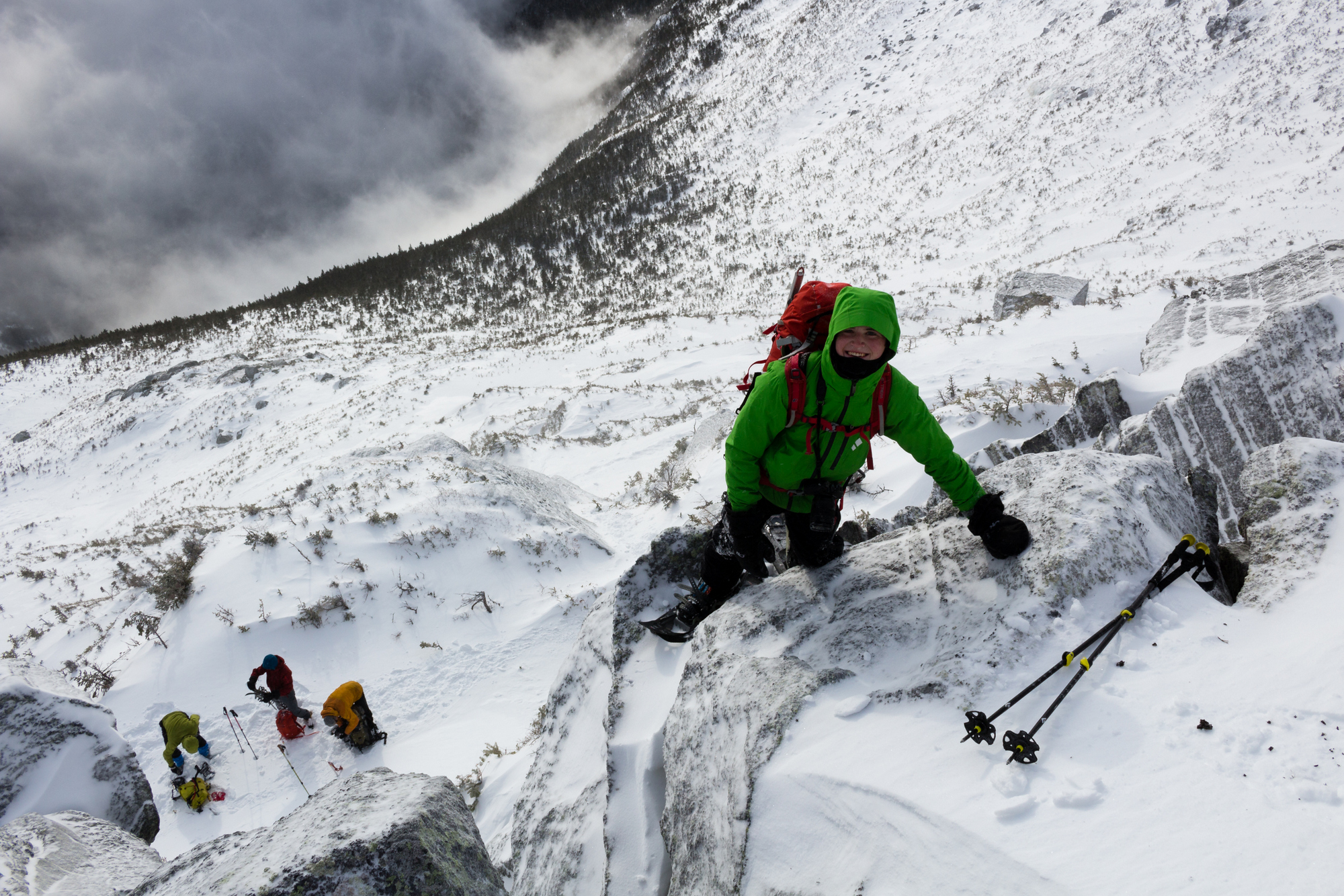
Snowshoe scrambling: fun for all the family. Photo: Nils Cuinat-Guerraz
With a little swearing, and a lot more trailbreaking by Nils, we hit the ridgeline and bagged summit number two. Up high, those ferocious winds scour the terrain, so there’s no deep snow to wade through, just the occasional pocket of wind-loaded powder. Ditching the snowshoes (in most cases Nils was basically in love with his pair and refused to take them off “The Future!”), we jogged down Adams, to the trail junction where we’d have to start suffering again.
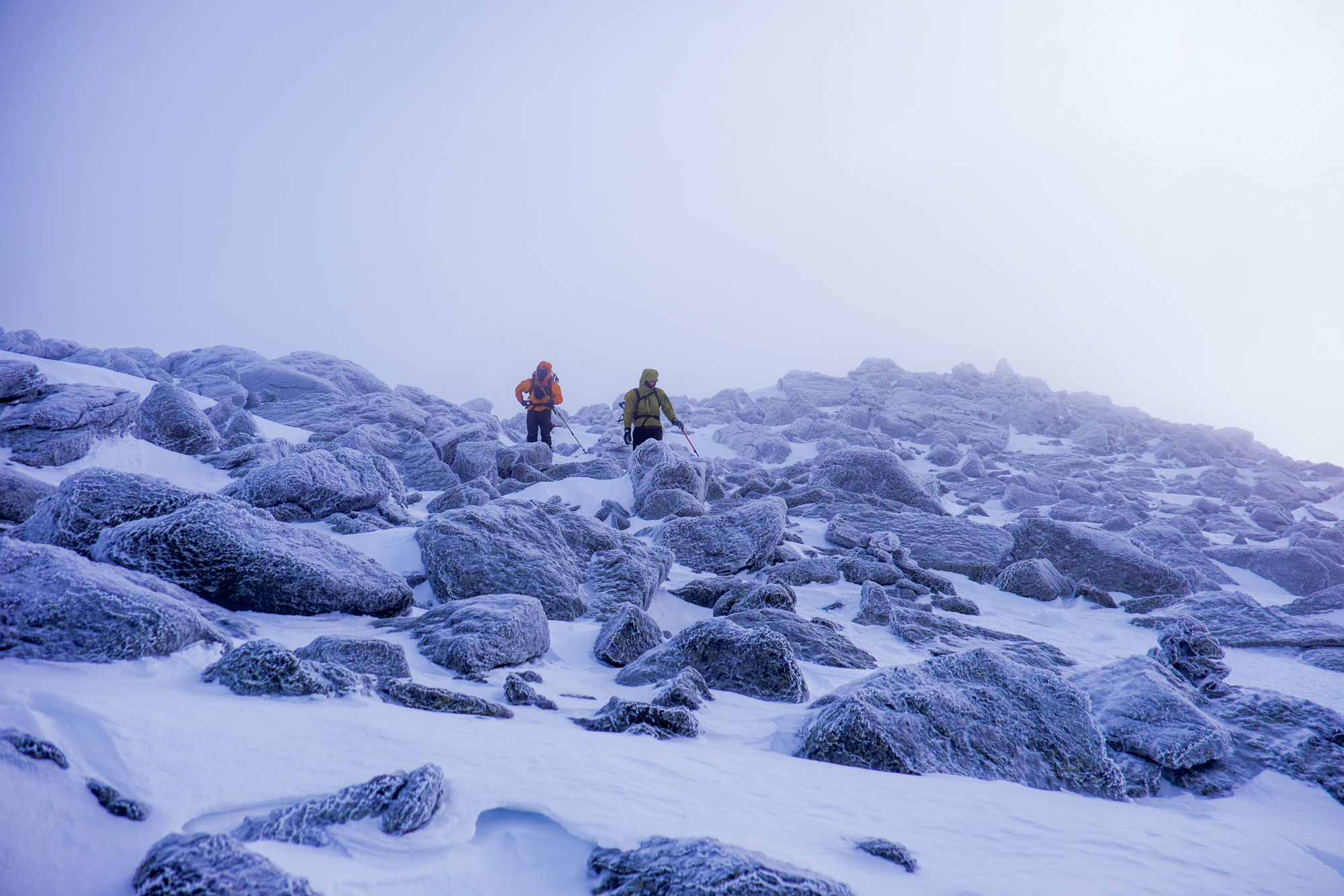
At Thunderstorm junction (no points for guessing the origin of the name!), we met the only other guy in the north end of the mountains: the AMC hut caretaker out for his morning hike. Resigned to the climb by this stage, we slogged up the side Jefferson, only stopping for the awesome view once we’d hit the summit.
On a good day, you can see the rest of the traverse splayed out from here: Washington rises above everything (and is immediately obvious thanks to the antenna farm on the summit), and the rest of the alpine ridge spreads out below. The path stretched further than we could see, which just hammered home the fact that we’d been moving for seven hours and weren’t even halfway there.
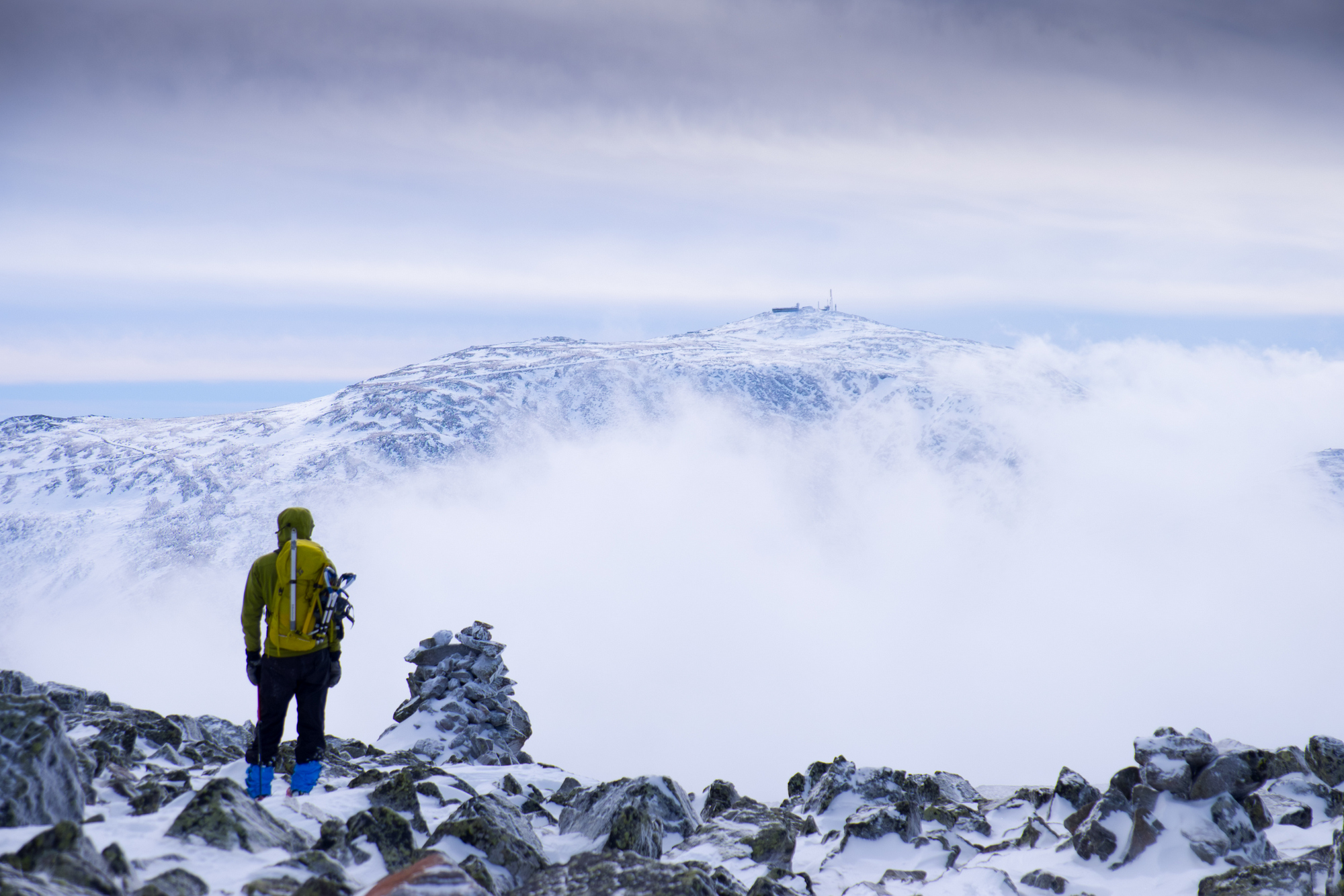
The section between Jefferson and Washington is sometimes called the ‘hamster wheel’, for good reason: it’s a few kilometres, mostly on the side of a hill that kills your ankles, with nothing in sight to give sense of progress. Eventually, you’ll come around the corner, and see civilisation everywhere: an auto road leading up one side, a cog railway winding up the other, and what looks like Satellite Dish City squatting on the top. After getting up at 1am and being blasted by the wind for eight hours, it seems kinda stupid.

Picture: Charlie Beard
We hit the summit around 1pm, took our photos with the rest of the climbers (Washington is an enjoyable day hike by other routes), and set off down. Although the weather was friendly for most of the day, the winds hit 96km/h on the summit. It’s a good reminder of how deadly these mountains can be. Washington used to hold highest recorded wind speed in the world, at 372km/h. Spend any time up there in those sorts of conditions, and the wind will force you to crawl; the windchill can give you hypothermia in minutes.

Picture: Charlie Beard
The next stop, after a fun descent where I only fell on my butt seven or eight times (OK, probably snowshoe time again) is the Lake of the Clouds hut. Again, in summer, this is a chill spot by a good swimming lake. Today, it was just another pile of snow-covered rocks. We took a short break for food, and finished all but the last sips of water. That was our only other mistake: we took 1-2 litres of water per person for the trip, but dehydration hit us all pretty hard by the end. It was not necessarily a major problem: if we’d needed to, we could have stopped to melt snow with the stove, but by the time we were over Washington, we were just keen to get down to those beers.
The last three peaks are all small, and they passed in a blur. From the Lake of the Clouds hut, the trail kicks straight up 90m to the summit of Mt Monroe, giving awesome views of the rest of the range with Washington slap-bang in the foreground. From there, the trail cruises downwards, pausing briefly to hop over Mt Eisenhower (home to, I think, the biggest summit cairn on earth) before dropping down to the treeline.
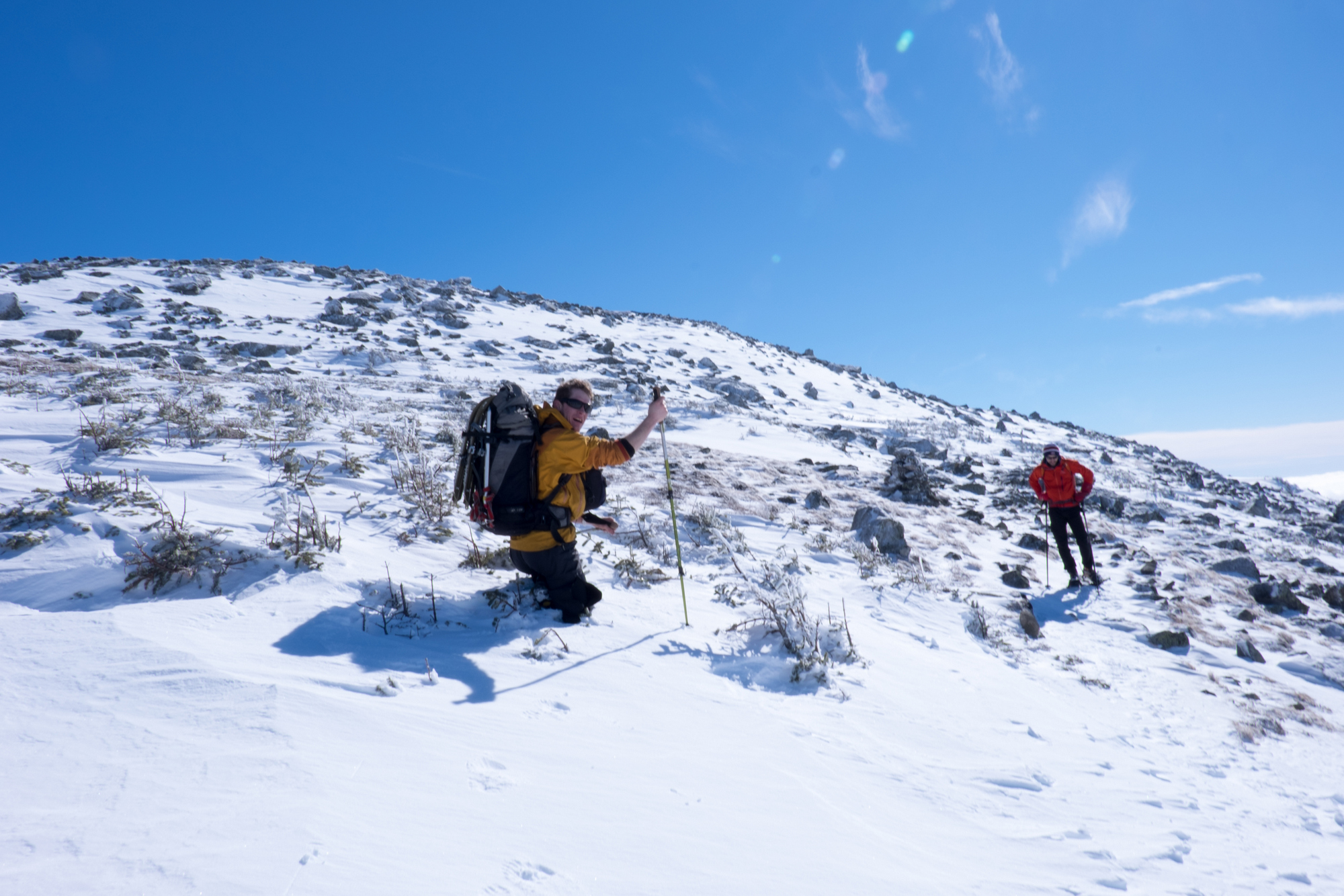
The final kick in the teeth is the last climb up to Mt Pierce: the trail winds uphill for a 800m below treeline, where windslab snow gives way again to soul-destroying powder. We dumped our packs at the junction where the trail goes down to Crawford Notch and the cars, pausing to run the couple hundred meters to the summit of Pierce. And, in my case, collapse. Dehydration is a bitch.

Drink water, or you’ll end up looking like this.
It was 4.30pm, and we didn’t want to get caught out after dark. By this stage, Nate and I were seriously lagging behind. 35km and 3000m of elevation had completely murdered my legs, and I’d had about two sips of water in the same number of hours. I’m pretty good at reading my body’s pain signals, and sitting at that trail junction, there wasn’t a whole lot left in the tank.
Thankfully, the trail down was a cruise. Unlike the way up, it had been broken earlier in the day by a group of snowshoers, so it was an easy few kilometres downhill to the car. Even a zombie like me could pull this off with no energy. Nils and Julien — the crazy, healthy-knee f**kers — ran the last few kilometres down to warm the car up, while Charlie and I limped down whinging about the lack of cartilage in our joints.
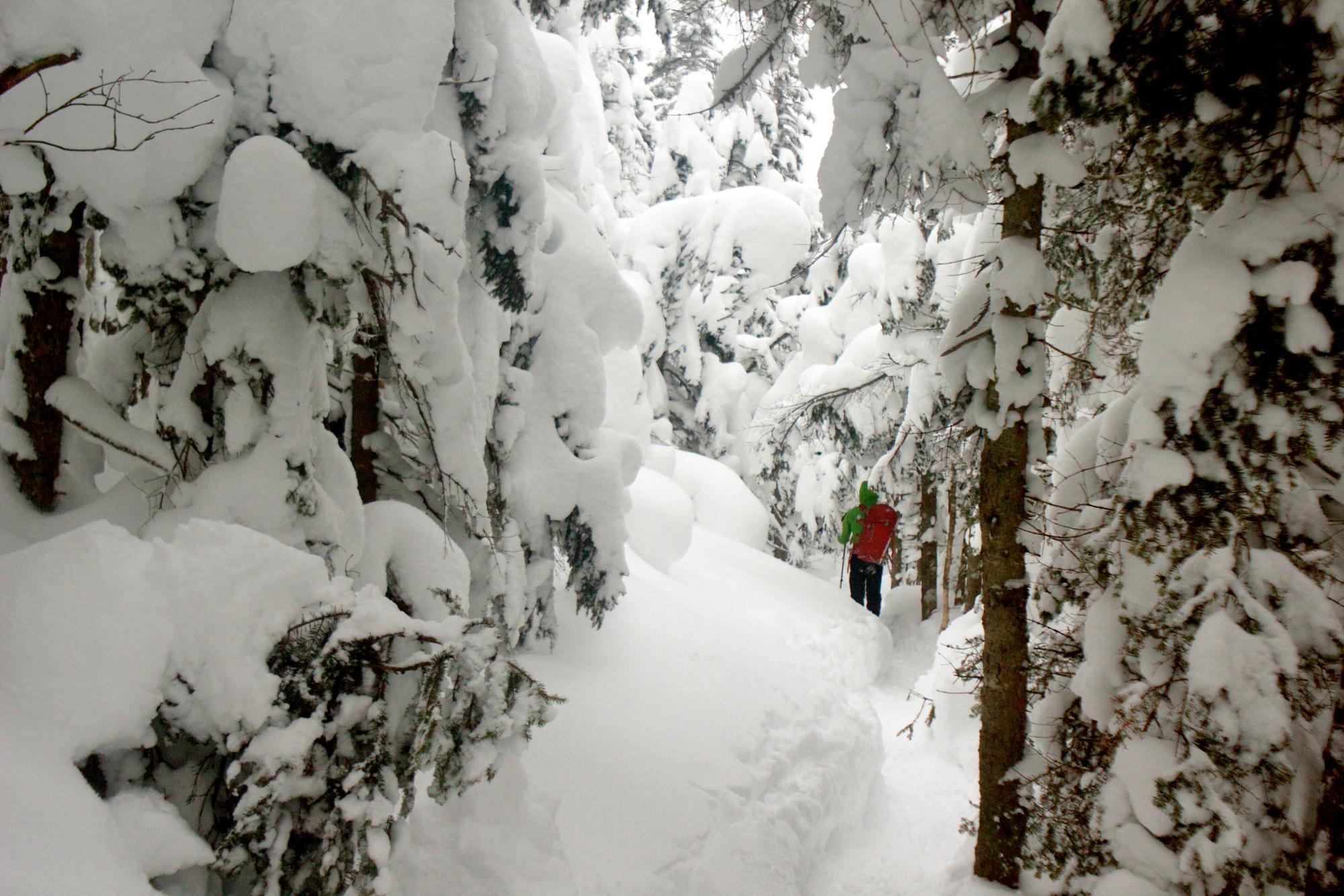
Picture: Charlie Beard
We got down to our car at Crawford Notch just after sunset, around 5.30pm — 14 hours on the trail. At the trailhead, there’s an AMC lodge, which was full of 50-somethings eating sit-down dinner with wine. They looked singularly unimpressed as we piled through the doors and bought them out of bottled water. But who gives — it was an awesome adventure, one of my best days out in the mountains. And no one even got frostbite.
Want To Traverse The Presidentials Yourself?
The full traverse, especially in winter, isn’t something to take lightly. The woman who died on the ridge the weekend before us wasn’t a tourist out of place: by all accounts, she was well-prepared, properly equipped, and aside from a few questionable decisions (I’d never head up there alone in winter) wasn’t being stupid. The weather is the key: get the hills on a good day, like we managed, and you’ll be fine. But we were ready to bail on the route if the wind picked up, and we never would have headed down in the first place if the forecast was crap.
Doom and gloom aside, though, the Whites (and Washington) in particular are awesome places to visit in the winter. In summer, the railway and the road up to the summit are open, and it’s swarming with tourists; in winter, there are 30 people up there on a good day. Plus, the snow adds something to the desolate feel.

By the easier routes, Washington is a good day hike for anyone reasonably fit and experienced in the outdoors (but bearing in mind how bad the weather gets and how quick it shifts). If you’re in doubt, a bunch of good guiding outfits lead trips in the area, and they can help make sure you’ve got the right gear (and experience) for the conditions.
If you do want to go yourself, there’s a ton of good info and maps for the area. The Appalachian Mountain Club publishes a guide to the range (with a map) that’s pretty decent.
What You Need
Having the right clothing is obviously a must in the mountains in winter. You’ll need an appropriate base layer, insulating mid-layers, and a windproof shell outer. The same goes for your legs. A balaclava and goggles will protect your face if the wind gets up — frostbite can develop in minutes on exposed parts of your face up there.
Warm boots will keep your toes from freezing. Old-school wisdom would have you take double plastic boots, which are toasty warm but stupidly heavy. We were all wearing regular mountaineering boots which worked fine, but on a colder day it might’ve been a different story. At the very least, you need warm, sturdy hiking boots fit large to accommodate thick, high-quality socks.

Picture: Nils Cuinat-Guerraz
Depending on the snow conditions and your choice of route, you’ll want to take some combination of crampons, snowshoes and microspikes. We packed mountaineering crampons and snowshoes, and spent pretty much all day in the latter, but if it’s been weeks since any serious snowfall, you could probably get away with just crampons or even microspikes.
Whatever you choose to put on your feet, you’ll want trekking poles in your hands. In deep snow and on unstable ground, they’re worth their weight in gold. We also took an ice axe apiece, but they barely came off the packs all day.
Other than that, we didn’t have many extras. Between the five of us, we had a snow shovel to dig a snow shelter if needed (though snowshoes work pretty well for that also), a stove to melt snow, a bivy bag, one sleeping bag in case someone got hurt and we had to spend hours dragging them off, a small first-aid kit, and a satellite beacon. Throw in a couple sandwiches, a few litres of water (in hindsight, I’d take at least 2) and a spare warm jacket, and you’ll only need a 20-litre backpack.
Picture: Charlie Beard
